Clothes and Self-Image: The Impact of Clothing on Personality and Perception
VerifiedAdded on 2023/06/14
|8
|2600
|397
AI Summary
This article explores the impact of clothing on personality and perception. It discusses how clothes are used for protection, modesty, and decoration, and how they communicate social worth and status. It also examines how clothing affects self-image and perception in the workplace and in social interactions.
Contribute Materials
Your contribution can guide someone’s learning journey. Share your
documents today.
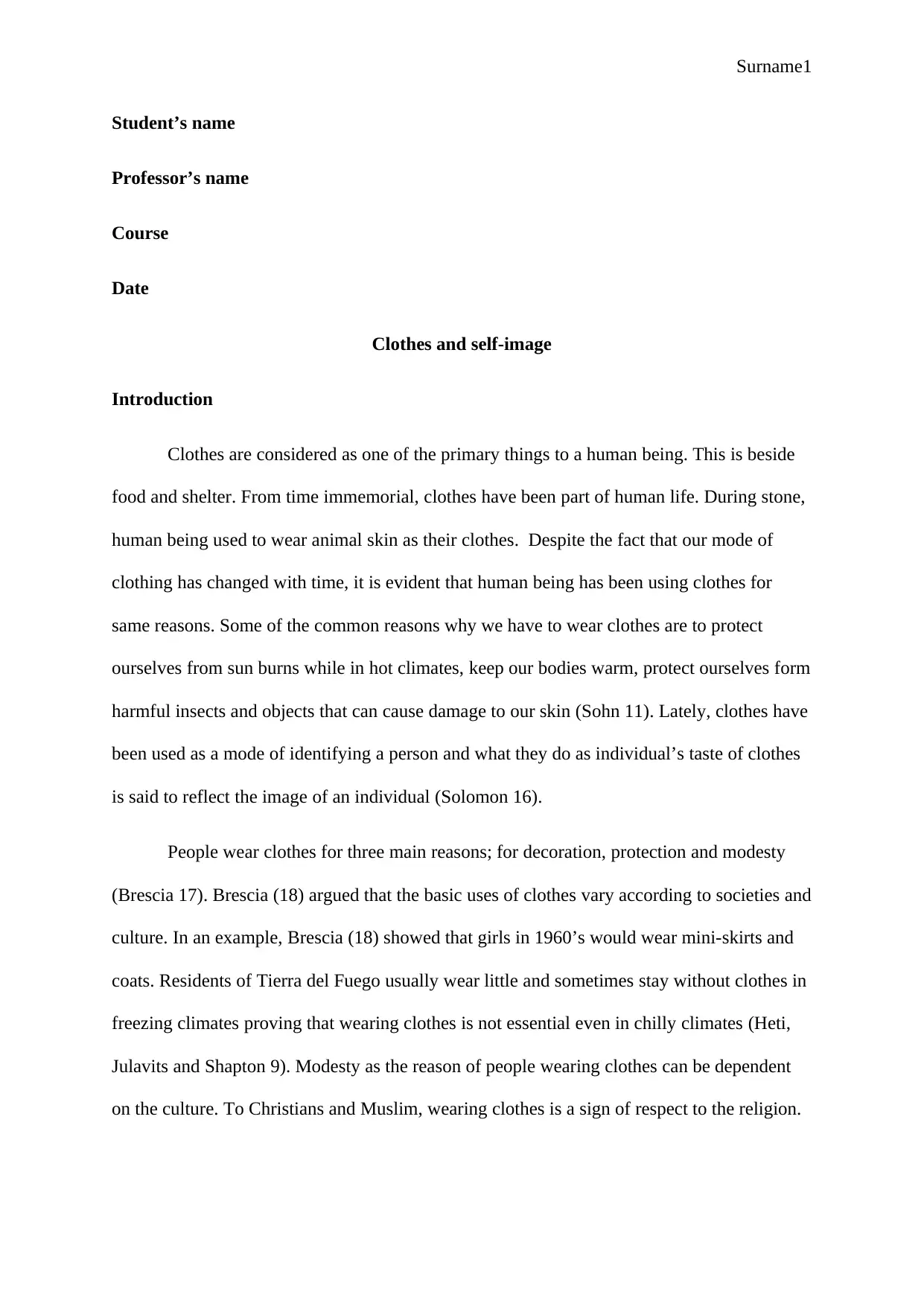
Surname1
Student’s name
Professor’s name
Course
Date
Clothes and self-image
Introduction
Clothes are considered as one of the primary things to a human being. This is beside
food and shelter. From time immemorial, clothes have been part of human life. During stone,
human being used to wear animal skin as their clothes. Despite the fact that our mode of
clothing has changed with time, it is evident that human being has been using clothes for
same reasons. Some of the common reasons why we have to wear clothes are to protect
ourselves from sun burns while in hot climates, keep our bodies warm, protect ourselves form
harmful insects and objects that can cause damage to our skin (Sohn 11). Lately, clothes have
been used as a mode of identifying a person and what they do as individual’s taste of clothes
is said to reflect the image of an individual (Solomon 16).
People wear clothes for three main reasons; for decoration, protection and modesty
(Brescia 17). Brescia (18) argued that the basic uses of clothes vary according to societies and
culture. In an example, Brescia (18) showed that girls in 1960’s would wear mini-skirts and
coats. Residents of Tierra del Fuego usually wear little and sometimes stay without clothes in
freezing climates proving that wearing clothes is not essential even in chilly climates (Heti,
Julavits and Shapton 9). Modesty as the reason of people wearing clothes can be dependent
on the culture. To Christians and Muslim, wearing clothes is a sign of respect to the religion.
Student’s name
Professor’s name
Course
Date
Clothes and self-image
Introduction
Clothes are considered as one of the primary things to a human being. This is beside
food and shelter. From time immemorial, clothes have been part of human life. During stone,
human being used to wear animal skin as their clothes. Despite the fact that our mode of
clothing has changed with time, it is evident that human being has been using clothes for
same reasons. Some of the common reasons why we have to wear clothes are to protect
ourselves from sun burns while in hot climates, keep our bodies warm, protect ourselves form
harmful insects and objects that can cause damage to our skin (Sohn 11). Lately, clothes have
been used as a mode of identifying a person and what they do as individual’s taste of clothes
is said to reflect the image of an individual (Solomon 16).
People wear clothes for three main reasons; for decoration, protection and modesty
(Brescia 17). Brescia (18) argued that the basic uses of clothes vary according to societies and
culture. In an example, Brescia (18) showed that girls in 1960’s would wear mini-skirts and
coats. Residents of Tierra del Fuego usually wear little and sometimes stay without clothes in
freezing climates proving that wearing clothes is not essential even in chilly climates (Heti,
Julavits and Shapton 9). Modesty as the reason of people wearing clothes can be dependent
on the culture. To Christians and Muslim, wearing clothes is a sign of respect to the religion.
Secure Best Marks with AI Grader
Need help grading? Try our AI Grader for instant feedback on your assignments.
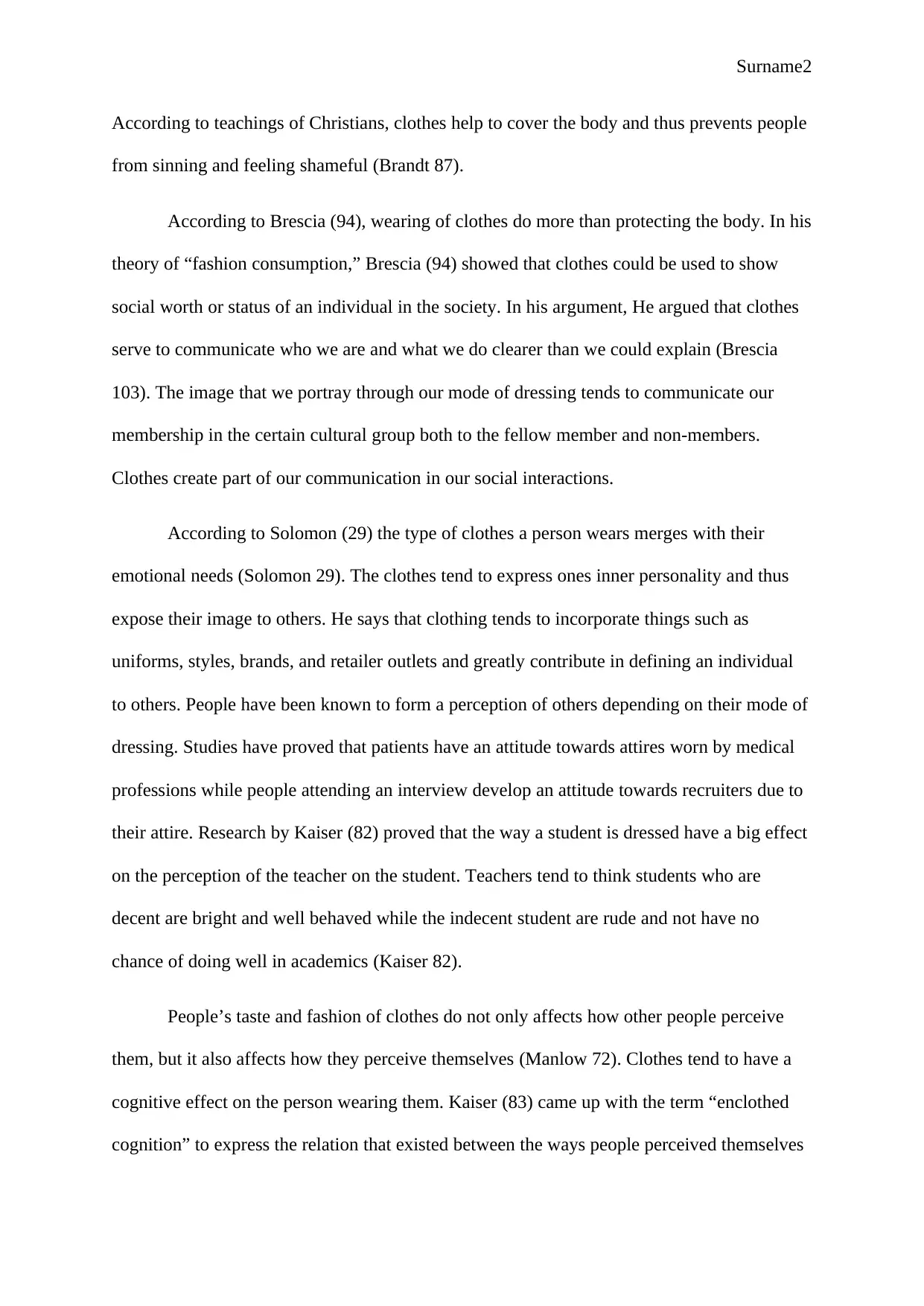
Surname2
According to teachings of Christians, clothes help to cover the body and thus prevents people
from sinning and feeling shameful (Brandt 87).
According to Brescia (94), wearing of clothes do more than protecting the body. In his
theory of “fashion consumption,” Brescia (94) showed that clothes could be used to show
social worth or status of an individual in the society. In his argument, He argued that clothes
serve to communicate who we are and what we do clearer than we could explain (Brescia
103). The image that we portray through our mode of dressing tends to communicate our
membership in the certain cultural group both to the fellow member and non-members.
Clothes create part of our communication in our social interactions.
According to Solomon (29) the type of clothes a person wears merges with their
emotional needs (Solomon 29). The clothes tend to express ones inner personality and thus
expose their image to others. He says that clothing tends to incorporate things such as
uniforms, styles, brands, and retailer outlets and greatly contribute in defining an individual
to others. People have been known to form a perception of others depending on their mode of
dressing. Studies have proved that patients have an attitude towards attires worn by medical
professions while people attending an interview develop an attitude towards recruiters due to
their attire. Research by Kaiser (82) proved that the way a student is dressed have a big effect
on the perception of the teacher on the student. Teachers tend to think students who are
decent are bright and well behaved while the indecent student are rude and not have no
chance of doing well in academics (Kaiser 82).
People’s taste and fashion of clothes do not only affects how other people perceive
them, but it also affects how they perceive themselves (Manlow 72). Clothes tend to have a
cognitive effect on the person wearing them. Kaiser (83) came up with the term “enclothed
cognition” to express the relation that existed between the ways people perceived themselves
According to teachings of Christians, clothes help to cover the body and thus prevents people
from sinning and feeling shameful (Brandt 87).
According to Brescia (94), wearing of clothes do more than protecting the body. In his
theory of “fashion consumption,” Brescia (94) showed that clothes could be used to show
social worth or status of an individual in the society. In his argument, He argued that clothes
serve to communicate who we are and what we do clearer than we could explain (Brescia
103). The image that we portray through our mode of dressing tends to communicate our
membership in the certain cultural group both to the fellow member and non-members.
Clothes create part of our communication in our social interactions.
According to Solomon (29) the type of clothes a person wears merges with their
emotional needs (Solomon 29). The clothes tend to express ones inner personality and thus
expose their image to others. He says that clothing tends to incorporate things such as
uniforms, styles, brands, and retailer outlets and greatly contribute in defining an individual
to others. People have been known to form a perception of others depending on their mode of
dressing. Studies have proved that patients have an attitude towards attires worn by medical
professions while people attending an interview develop an attitude towards recruiters due to
their attire. Research by Kaiser (82) proved that the way a student is dressed have a big effect
on the perception of the teacher on the student. Teachers tend to think students who are
decent are bright and well behaved while the indecent student are rude and not have no
chance of doing well in academics (Kaiser 82).
People’s taste and fashion of clothes do not only affects how other people perceive
them, but it also affects how they perceive themselves (Manlow 72). Clothes tend to have a
cognitive effect on the person wearing them. Kaiser (83) came up with the term “enclothed
cognition” to express the relation that existed between the ways people perceived themselves
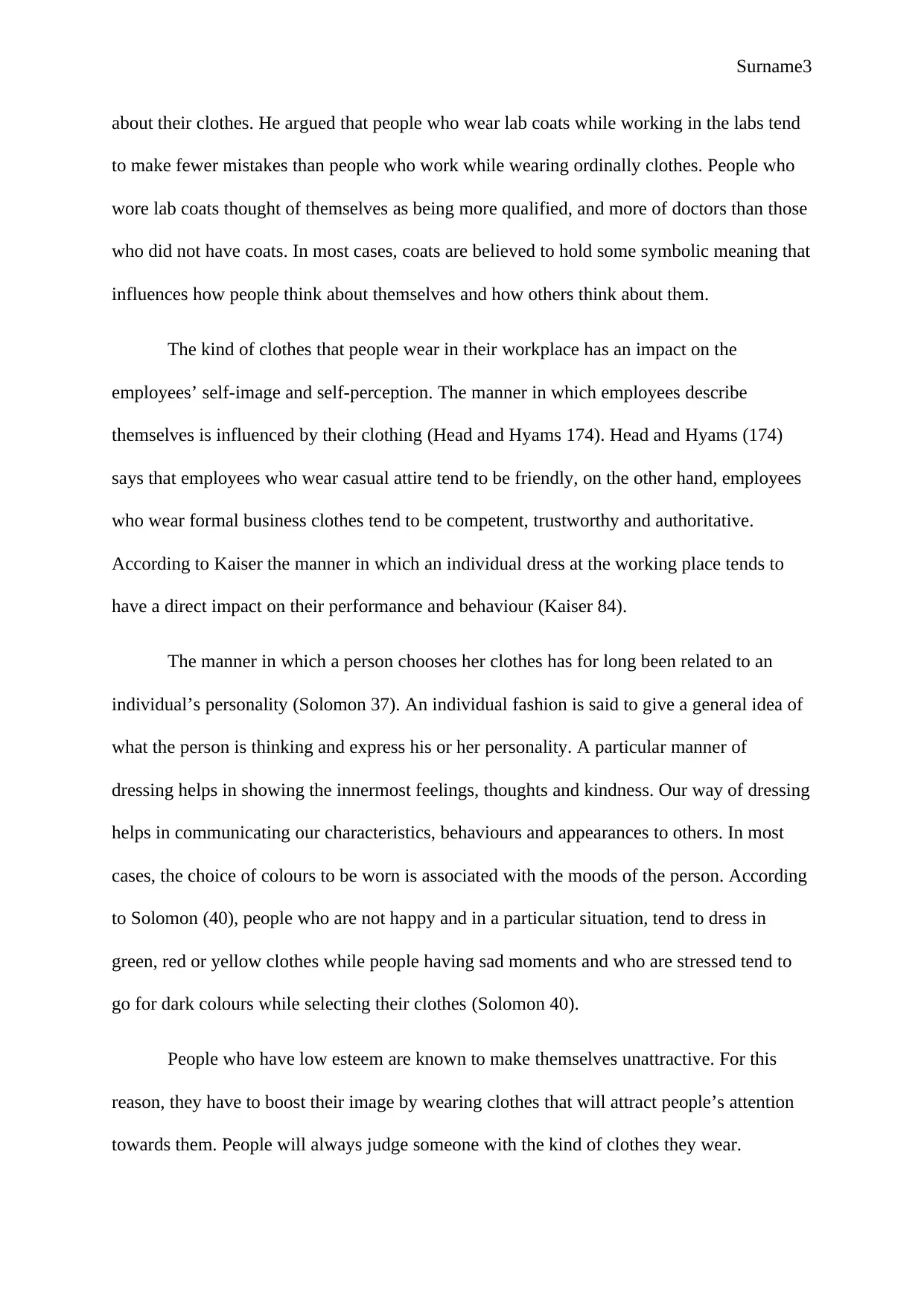
Surname3
about their clothes. He argued that people who wear lab coats while working in the labs tend
to make fewer mistakes than people who work while wearing ordinally clothes. People who
wore lab coats thought of themselves as being more qualified, and more of doctors than those
who did not have coats. In most cases, coats are believed to hold some symbolic meaning that
influences how people think about themselves and how others think about them.
The kind of clothes that people wear in their workplace has an impact on the
employees’ self-image and self-perception. The manner in which employees describe
themselves is influenced by their clothing (Head and Hyams 174). Head and Hyams (174)
says that employees who wear casual attire tend to be friendly, on the other hand, employees
who wear formal business clothes tend to be competent, trustworthy and authoritative.
According to Kaiser the manner in which an individual dress at the working place tends to
have a direct impact on their performance and behaviour (Kaiser 84).
The manner in which a person chooses her clothes has for long been related to an
individual’s personality (Solomon 37). An individual fashion is said to give a general idea of
what the person is thinking and express his or her personality. A particular manner of
dressing helps in showing the innermost feelings, thoughts and kindness. Our way of dressing
helps in communicating our characteristics, behaviours and appearances to others. In most
cases, the choice of colours to be worn is associated with the moods of the person. According
to Solomon (40), people who are not happy and in a particular situation, tend to dress in
green, red or yellow clothes while people having sad moments and who are stressed tend to
go for dark colours while selecting their clothes (Solomon 40).
People who have low esteem are known to make themselves unattractive. For this
reason, they have to boost their image by wearing clothes that will attract people’s attention
towards them. People will always judge someone with the kind of clothes they wear.
about their clothes. He argued that people who wear lab coats while working in the labs tend
to make fewer mistakes than people who work while wearing ordinally clothes. People who
wore lab coats thought of themselves as being more qualified, and more of doctors than those
who did not have coats. In most cases, coats are believed to hold some symbolic meaning that
influences how people think about themselves and how others think about them.
The kind of clothes that people wear in their workplace has an impact on the
employees’ self-image and self-perception. The manner in which employees describe
themselves is influenced by their clothing (Head and Hyams 174). Head and Hyams (174)
says that employees who wear casual attire tend to be friendly, on the other hand, employees
who wear formal business clothes tend to be competent, trustworthy and authoritative.
According to Kaiser the manner in which an individual dress at the working place tends to
have a direct impact on their performance and behaviour (Kaiser 84).
The manner in which a person chooses her clothes has for long been related to an
individual’s personality (Solomon 37). An individual fashion is said to give a general idea of
what the person is thinking and express his or her personality. A particular manner of
dressing helps in showing the innermost feelings, thoughts and kindness. Our way of dressing
helps in communicating our characteristics, behaviours and appearances to others. In most
cases, the choice of colours to be worn is associated with the moods of the person. According
to Solomon (40), people who are not happy and in a particular situation, tend to dress in
green, red or yellow clothes while people having sad moments and who are stressed tend to
go for dark colours while selecting their clothes (Solomon 40).
People who have low esteem are known to make themselves unattractive. For this
reason, they have to boost their image by wearing clothes that will attract people’s attention
towards them. People will always judge someone with the kind of clothes they wear.
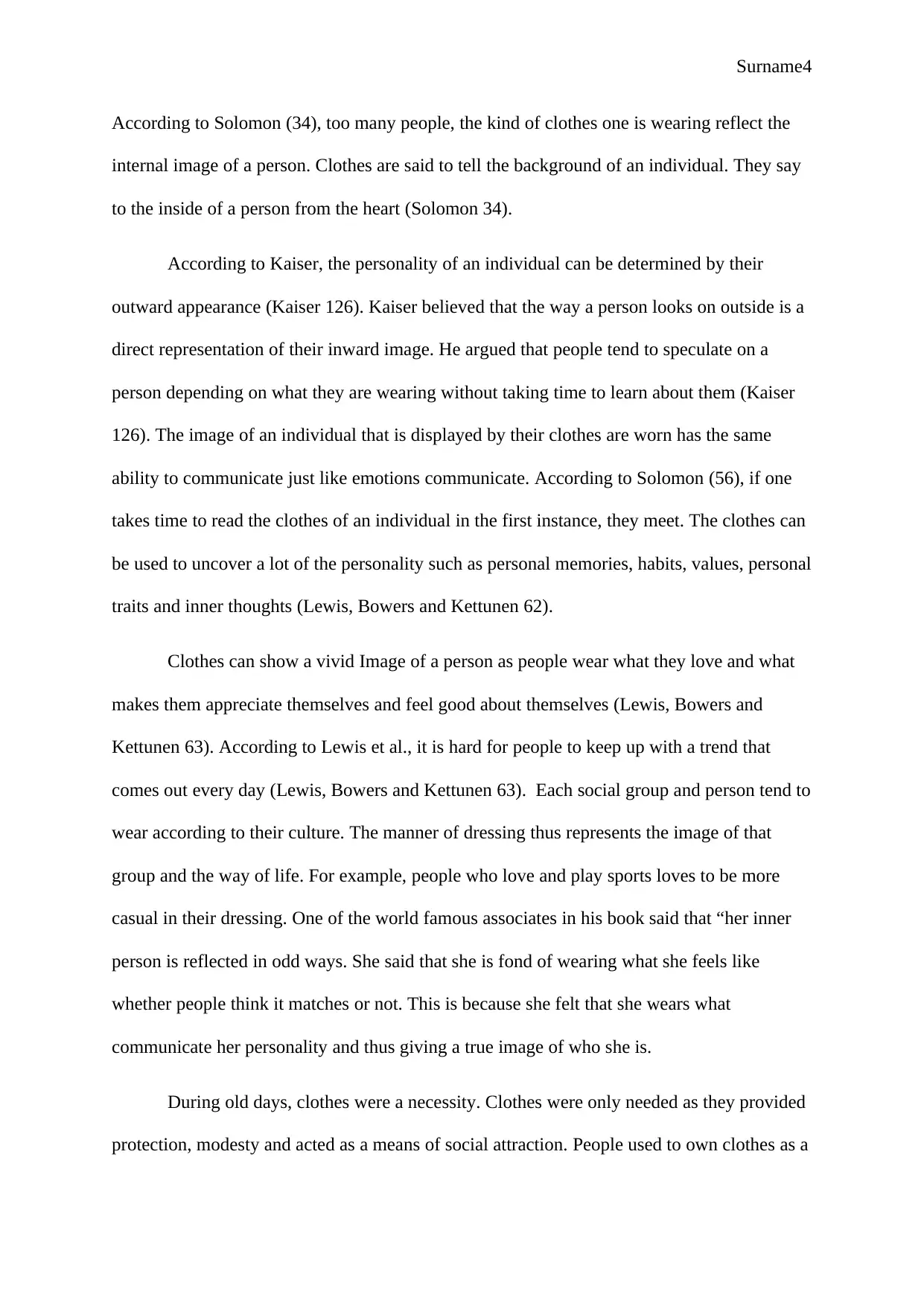
Surname4
According to Solomon (34), too many people, the kind of clothes one is wearing reflect the
internal image of a person. Clothes are said to tell the background of an individual. They say
to the inside of a person from the heart (Solomon 34).
According to Kaiser, the personality of an individual can be determined by their
outward appearance (Kaiser 126). Kaiser believed that the way a person looks on outside is a
direct representation of their inward image. He argued that people tend to speculate on a
person depending on what they are wearing without taking time to learn about them (Kaiser
126). The image of an individual that is displayed by their clothes are worn has the same
ability to communicate just like emotions communicate. According to Solomon (56), if one
takes time to read the clothes of an individual in the first instance, they meet. The clothes can
be used to uncover a lot of the personality such as personal memories, habits, values, personal
traits and inner thoughts (Lewis, Bowers and Kettunen 62).
Clothes can show a vivid Image of a person as people wear what they love and what
makes them appreciate themselves and feel good about themselves (Lewis, Bowers and
Kettunen 63). According to Lewis et al., it is hard for people to keep up with a trend that
comes out every day (Lewis, Bowers and Kettunen 63). Each social group and person tend to
wear according to their culture. The manner of dressing thus represents the image of that
group and the way of life. For example, people who love and play sports loves to be more
casual in their dressing. One of the world famous associates in his book said that “her inner
person is reflected in odd ways. She said that she is fond of wearing what she feels like
whether people think it matches or not. This is because she felt that she wears what
communicate her personality and thus giving a true image of who she is.
During old days, clothes were a necessity. Clothes were only needed as they provided
protection, modesty and acted as a means of social attraction. People used to own clothes as a
According to Solomon (34), too many people, the kind of clothes one is wearing reflect the
internal image of a person. Clothes are said to tell the background of an individual. They say
to the inside of a person from the heart (Solomon 34).
According to Kaiser, the personality of an individual can be determined by their
outward appearance (Kaiser 126). Kaiser believed that the way a person looks on outside is a
direct representation of their inward image. He argued that people tend to speculate on a
person depending on what they are wearing without taking time to learn about them (Kaiser
126). The image of an individual that is displayed by their clothes are worn has the same
ability to communicate just like emotions communicate. According to Solomon (56), if one
takes time to read the clothes of an individual in the first instance, they meet. The clothes can
be used to uncover a lot of the personality such as personal memories, habits, values, personal
traits and inner thoughts (Lewis, Bowers and Kettunen 62).
Clothes can show a vivid Image of a person as people wear what they love and what
makes them appreciate themselves and feel good about themselves (Lewis, Bowers and
Kettunen 63). According to Lewis et al., it is hard for people to keep up with a trend that
comes out every day (Lewis, Bowers and Kettunen 63). Each social group and person tend to
wear according to their culture. The manner of dressing thus represents the image of that
group and the way of life. For example, people who love and play sports loves to be more
casual in their dressing. One of the world famous associates in his book said that “her inner
person is reflected in odd ways. She said that she is fond of wearing what she feels like
whether people think it matches or not. This is because she felt that she wears what
communicate her personality and thus giving a true image of who she is.
During old days, clothes were a necessity. Clothes were only needed as they provided
protection, modesty and acted as a means of social attraction. People used to own clothes as a
Secure Best Marks with AI Grader
Need help grading? Try our AI Grader for instant feedback on your assignments.
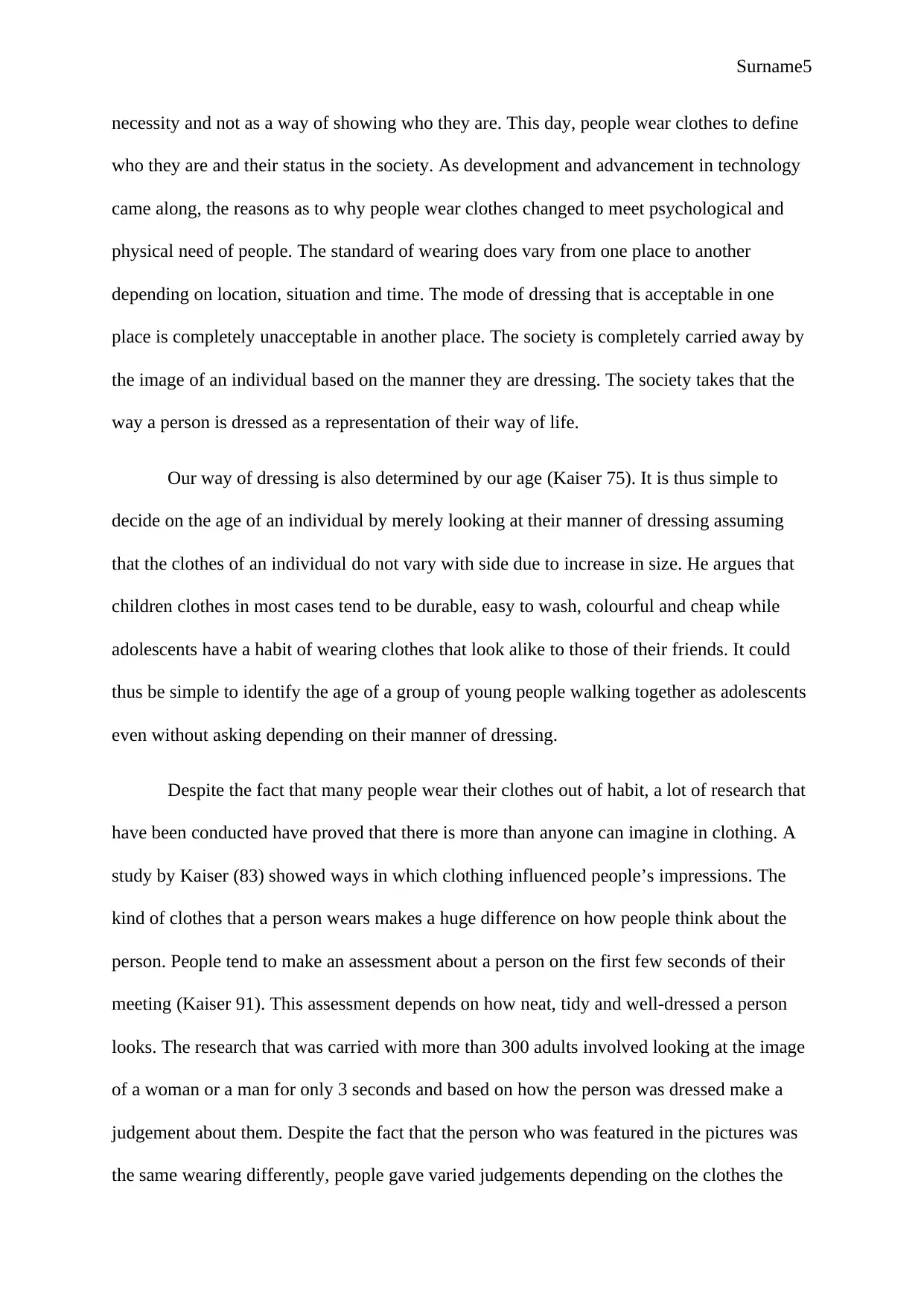
Surname5
necessity and not as a way of showing who they are. This day, people wear clothes to define
who they are and their status in the society. As development and advancement in technology
came along, the reasons as to why people wear clothes changed to meet psychological and
physical need of people. The standard of wearing does vary from one place to another
depending on location, situation and time. The mode of dressing that is acceptable in one
place is completely unacceptable in another place. The society is completely carried away by
the image of an individual based on the manner they are dressing. The society takes that the
way a person is dressed as a representation of their way of life.
Our way of dressing is also determined by our age (Kaiser 75). It is thus simple to
decide on the age of an individual by merely looking at their manner of dressing assuming
that the clothes of an individual do not vary with side due to increase in size. He argues that
children clothes in most cases tend to be durable, easy to wash, colourful and cheap while
adolescents have a habit of wearing clothes that look alike to those of their friends. It could
thus be simple to identify the age of a group of young people walking together as adolescents
even without asking depending on their manner of dressing.
Despite the fact that many people wear their clothes out of habit, a lot of research that
have been conducted have proved that there is more than anyone can imagine in clothing. A
study by Kaiser (83) showed ways in which clothing influenced people’s impressions. The
kind of clothes that a person wears makes a huge difference on how people think about the
person. People tend to make an assessment about a person on the first few seconds of their
meeting (Kaiser 91). This assessment depends on how neat, tidy and well-dressed a person
looks. The research that was carried with more than 300 adults involved looking at the image
of a woman or a man for only 3 seconds and based on how the person was dressed make a
judgement about them. Despite the fact that the person who was featured in the pictures was
the same wearing differently, people gave varied judgements depending on the clothes the
necessity and not as a way of showing who they are. This day, people wear clothes to define
who they are and their status in the society. As development and advancement in technology
came along, the reasons as to why people wear clothes changed to meet psychological and
physical need of people. The standard of wearing does vary from one place to another
depending on location, situation and time. The mode of dressing that is acceptable in one
place is completely unacceptable in another place. The society is completely carried away by
the image of an individual based on the manner they are dressing. The society takes that the
way a person is dressed as a representation of their way of life.
Our way of dressing is also determined by our age (Kaiser 75). It is thus simple to
decide on the age of an individual by merely looking at their manner of dressing assuming
that the clothes of an individual do not vary with side due to increase in size. He argues that
children clothes in most cases tend to be durable, easy to wash, colourful and cheap while
adolescents have a habit of wearing clothes that look alike to those of their friends. It could
thus be simple to identify the age of a group of young people walking together as adolescents
even without asking depending on their manner of dressing.
Despite the fact that many people wear their clothes out of habit, a lot of research that
have been conducted have proved that there is more than anyone can imagine in clothing. A
study by Kaiser (83) showed ways in which clothing influenced people’s impressions. The
kind of clothes that a person wears makes a huge difference on how people think about the
person. People tend to make an assessment about a person on the first few seconds of their
meeting (Kaiser 91). This assessment depends on how neat, tidy and well-dressed a person
looks. The research that was carried with more than 300 adults involved looking at the image
of a woman or a man for only 3 seconds and based on how the person was dressed make a
judgement about them. Despite the fact that the person who was featured in the pictures was
the same wearing differently, people gave varied judgements depending on the clothes the
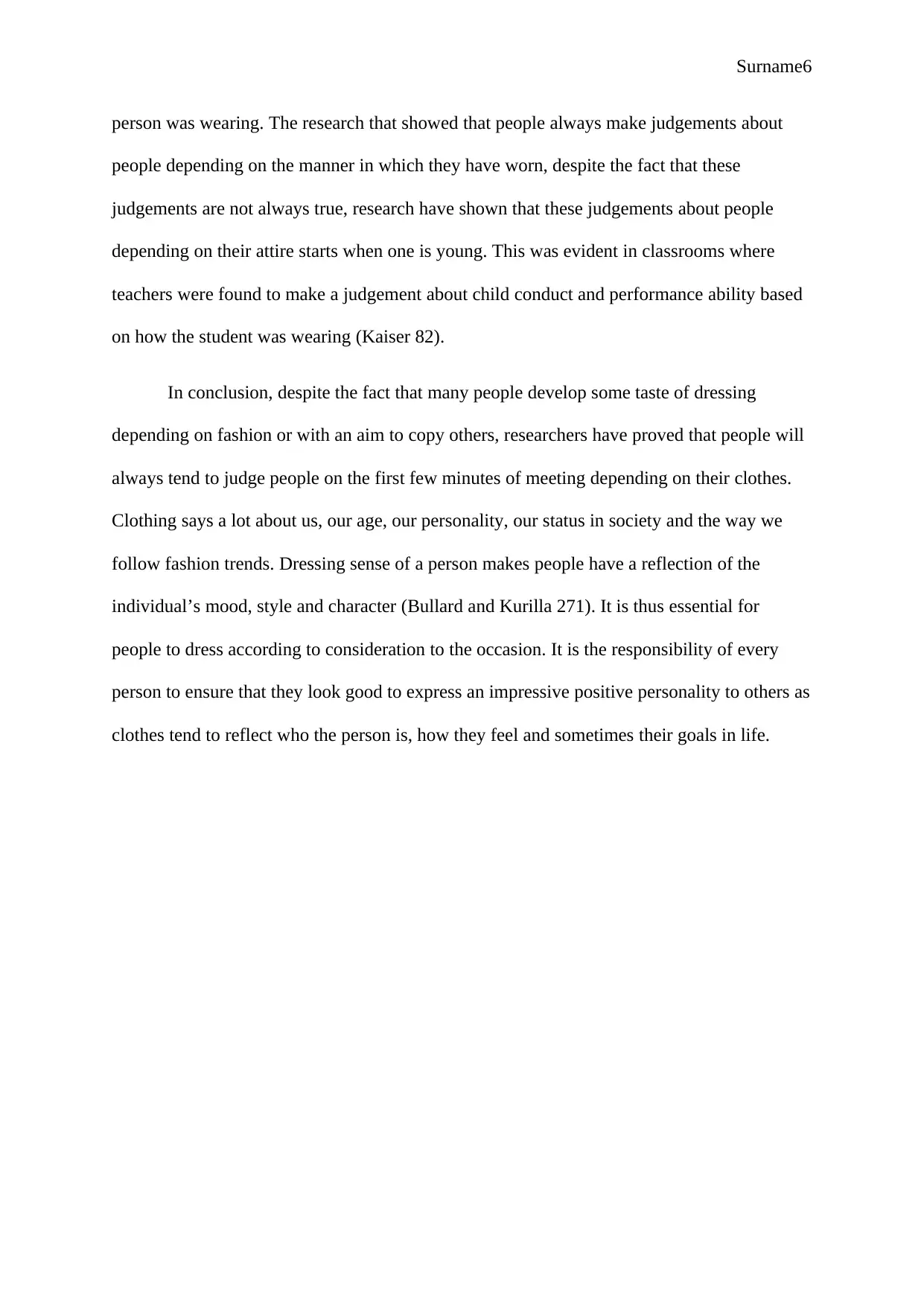
Surname6
person was wearing. The research that showed that people always make judgements about
people depending on the manner in which they have worn, despite the fact that these
judgements are not always true, research have shown that these judgements about people
depending on their attire starts when one is young. This was evident in classrooms where
teachers were found to make a judgement about child conduct and performance ability based
on how the student was wearing (Kaiser 82).
In conclusion, despite the fact that many people develop some taste of dressing
depending on fashion or with an aim to copy others, researchers have proved that people will
always tend to judge people on the first few minutes of meeting depending on their clothes.
Clothing says a lot about us, our age, our personality, our status in society and the way we
follow fashion trends. Dressing sense of a person makes people have a reflection of the
individual’s mood, style and character (Bullard and Kurilla 271). It is thus essential for
people to dress according to consideration to the occasion. It is the responsibility of every
person to ensure that they look good to express an impressive positive personality to others as
clothes tend to reflect who the person is, how they feel and sometimes their goals in life.
person was wearing. The research that showed that people always make judgements about
people depending on the manner in which they have worn, despite the fact that these
judgements are not always true, research have shown that these judgements about people
depending on their attire starts when one is young. This was evident in classrooms where
teachers were found to make a judgement about child conduct and performance ability based
on how the student was wearing (Kaiser 82).
In conclusion, despite the fact that many people develop some taste of dressing
depending on fashion or with an aim to copy others, researchers have proved that people will
always tend to judge people on the first few minutes of meeting depending on their clothes.
Clothing says a lot about us, our age, our personality, our status in society and the way we
follow fashion trends. Dressing sense of a person makes people have a reflection of the
individual’s mood, style and character (Bullard and Kurilla 271). It is thus essential for
people to dress according to consideration to the occasion. It is the responsibility of every
person to ensure that they look good to express an impressive positive personality to others as
clothes tend to reflect who the person is, how they feel and sometimes their goals in life.
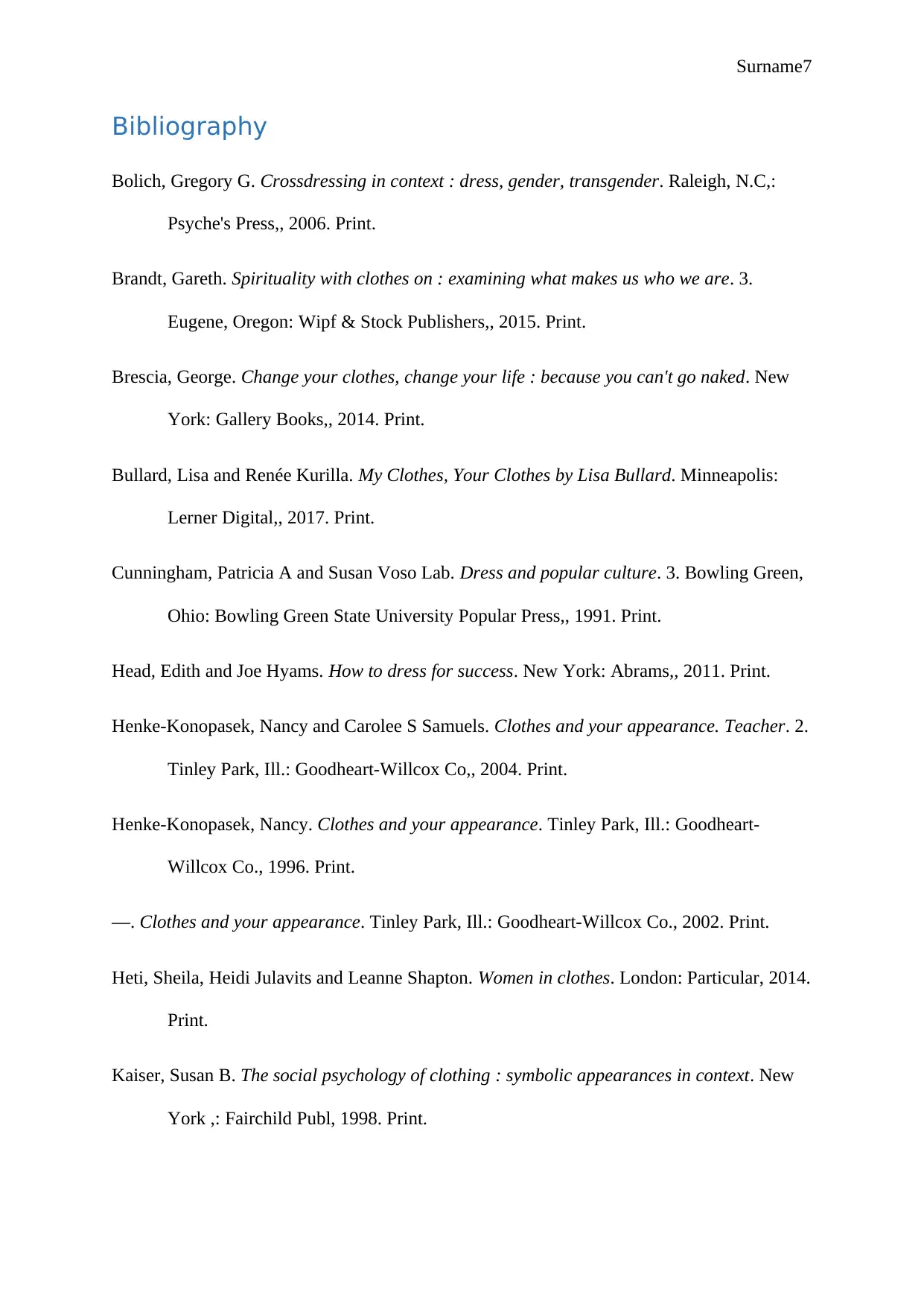
Surname7
Bibliography
Bolich, Gregory G. Crossdressing in context : dress, gender, transgender. Raleigh, N.C,:
Psyche's Press,, 2006. Print.
Brandt, Gareth. Spirituality with clothes on : examining what makes us who we are. 3.
Eugene, Oregon: Wipf & Stock Publishers,, 2015. Print.
Brescia, George. Change your clothes, change your life : because you can't go naked. New
York: Gallery Books,, 2014. Print.
Bullard, Lisa and Renée Kurilla. My Clothes, Your Clothes by Lisa Bullard. Minneapolis:
Lerner Digital,, 2017. Print.
Cunningham, Patricia A and Susan Voso Lab. Dress and popular culture. 3. Bowling Green,
Ohio: Bowling Green State University Popular Press,, 1991. Print.
Head, Edith and Joe Hyams. How to dress for success. New York: Abrams,, 2011. Print.
Henke-Konopasek, Nancy and Carolee S Samuels. Clothes and your appearance. Teacher. 2.
Tinley Park, Ill.: Goodheart-Willcox Co,, 2004. Print.
Henke-Konopasek, Nancy. Clothes and your appearance. Tinley Park, Ill.: Goodheart-
Willcox Co., 1996. Print.
—. Clothes and your appearance. Tinley Park, Ill.: Goodheart-Willcox Co., 2002. Print.
Heti, Sheila, Heidi Julavits and Leanne Shapton. Women in clothes. London: Particular, 2014.
Print.
Kaiser, Susan B. The social psychology of clothing : symbolic appearances in context. New
York ,: Fairchild Publ, 1998. Print.
Bibliography
Bolich, Gregory G. Crossdressing in context : dress, gender, transgender. Raleigh, N.C,:
Psyche's Press,, 2006. Print.
Brandt, Gareth. Spirituality with clothes on : examining what makes us who we are. 3.
Eugene, Oregon: Wipf & Stock Publishers,, 2015. Print.
Brescia, George. Change your clothes, change your life : because you can't go naked. New
York: Gallery Books,, 2014. Print.
Bullard, Lisa and Renée Kurilla. My Clothes, Your Clothes by Lisa Bullard. Minneapolis:
Lerner Digital,, 2017. Print.
Cunningham, Patricia A and Susan Voso Lab. Dress and popular culture. 3. Bowling Green,
Ohio: Bowling Green State University Popular Press,, 1991. Print.
Head, Edith and Joe Hyams. How to dress for success. New York: Abrams,, 2011. Print.
Henke-Konopasek, Nancy and Carolee S Samuels. Clothes and your appearance. Teacher. 2.
Tinley Park, Ill.: Goodheart-Willcox Co,, 2004. Print.
Henke-Konopasek, Nancy. Clothes and your appearance. Tinley Park, Ill.: Goodheart-
Willcox Co., 1996. Print.
—. Clothes and your appearance. Tinley Park, Ill.: Goodheart-Willcox Co., 2002. Print.
Heti, Sheila, Heidi Julavits and Leanne Shapton. Women in clothes. London: Particular, 2014.
Print.
Kaiser, Susan B. The social psychology of clothing : symbolic appearances in context. New
York ,: Fairchild Publ, 1998. Print.
Paraphrase This Document
Need a fresh take? Get an instant paraphrase of this document with our AI Paraphraser
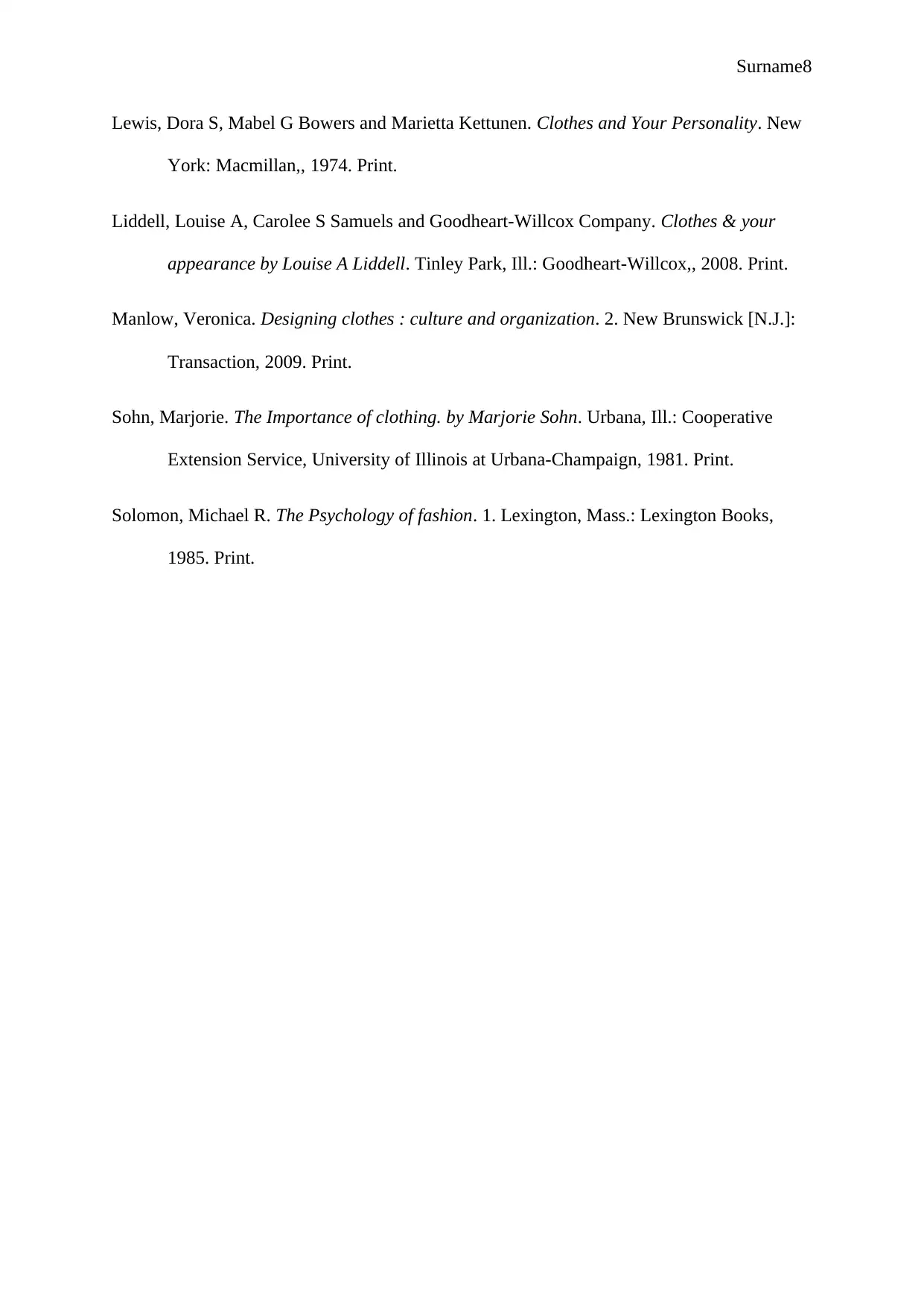
Surname8
Lewis, Dora S, Mabel G Bowers and Marietta Kettunen. Clothes and Your Personality. New
York: Macmillan,, 1974. Print.
Liddell, Louise A, Carolee S Samuels and Goodheart-Willcox Company. Clothes & your
appearance by Louise A Liddell. Tinley Park, Ill.: Goodheart-Willcox,, 2008. Print.
Manlow, Veronica. Designing clothes : culture and organization. 2. New Brunswick [N.J.]:
Transaction, 2009. Print.
Sohn, Marjorie. The Importance of clothing. by Marjorie Sohn. Urbana, Ill.: Cooperative
Extension Service, University of Illinois at Urbana-Champaign, 1981. Print.
Solomon, Michael R. The Psychology of fashion. 1. Lexington, Mass.: Lexington Books,
1985. Print.
Lewis, Dora S, Mabel G Bowers and Marietta Kettunen. Clothes and Your Personality. New
York: Macmillan,, 1974. Print.
Liddell, Louise A, Carolee S Samuels and Goodheart-Willcox Company. Clothes & your
appearance by Louise A Liddell. Tinley Park, Ill.: Goodheart-Willcox,, 2008. Print.
Manlow, Veronica. Designing clothes : culture and organization. 2. New Brunswick [N.J.]:
Transaction, 2009. Print.
Sohn, Marjorie. The Importance of clothing. by Marjorie Sohn. Urbana, Ill.: Cooperative
Extension Service, University of Illinois at Urbana-Champaign, 1981. Print.
Solomon, Michael R. The Psychology of fashion. 1. Lexington, Mass.: Lexington Books,
1985. Print.
1 out of 8
Your All-in-One AI-Powered Toolkit for Academic Success.
+13062052269
info@desklib.com
Available 24*7 on WhatsApp / Email
![[object Object]](/_next/static/media/star-bottom.7253800d.svg)
Unlock your academic potential
© 2024 | Zucol Services PVT LTD | All rights reserved.